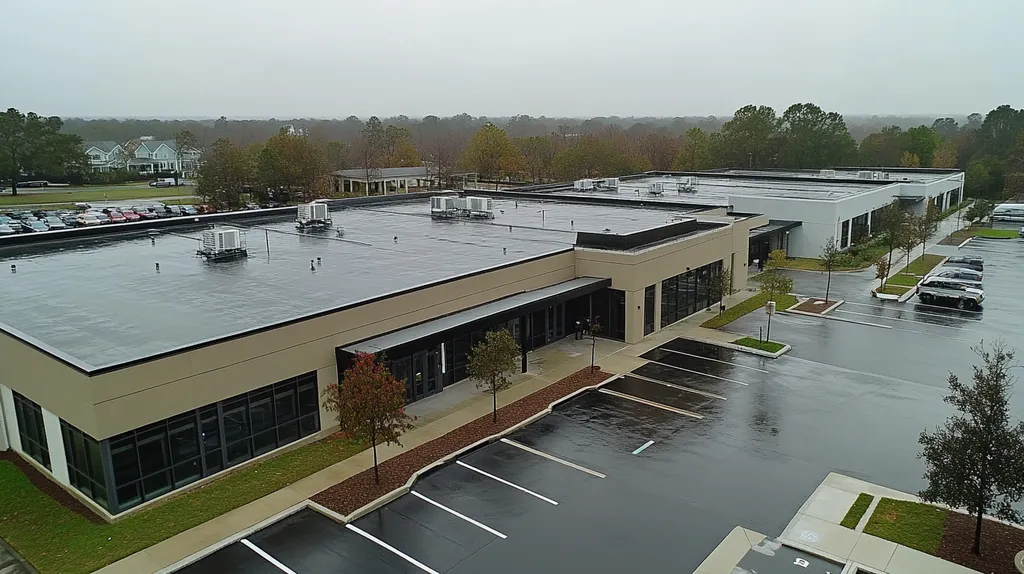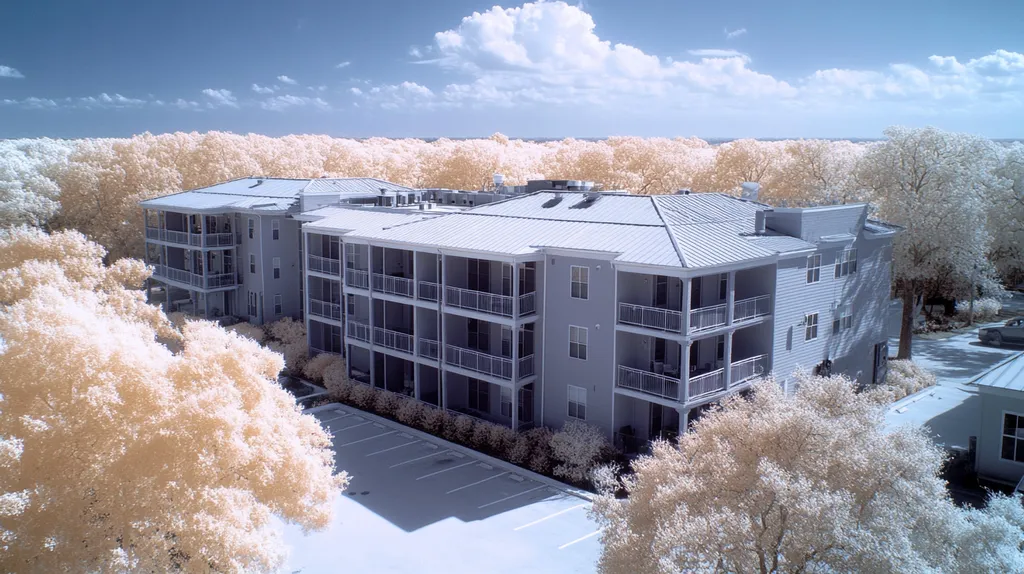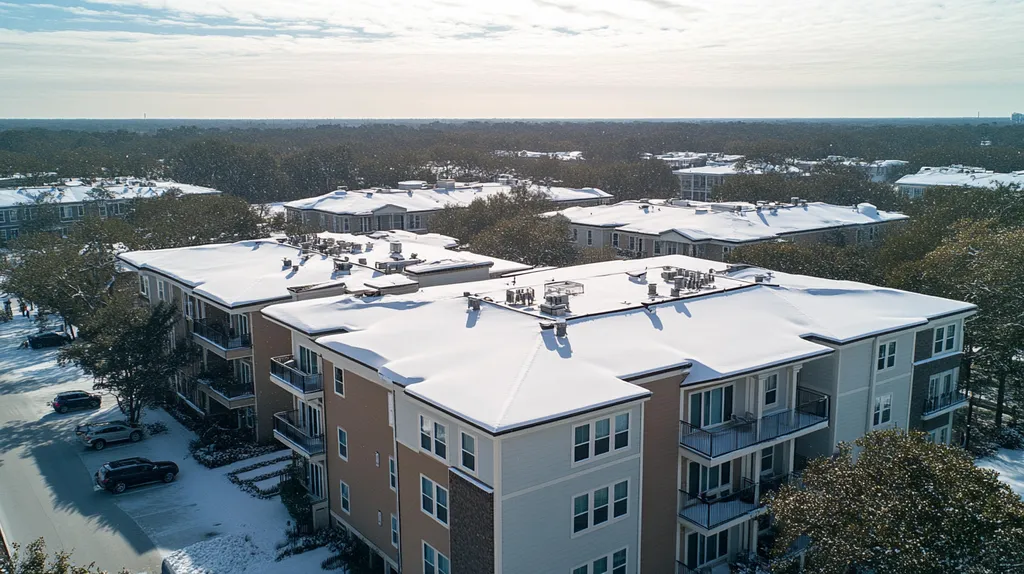Welcome to today’s Battle Royale featuring two roofing heavyweights: “TPO” in the east corner versus “PVC” in the west!
Tonight’s showdown pits these contenders against each other across six punishing rounds designed to test every aspect of their performance for Moisture Impact on Energy Efficiency of Commercial Roofs.
At stake? Millions in potential costs, decades of building protection, and the critical performance demands of modern commercial and industrial facilities.
Our professional judging panel will evaluate each round on technical merit, real-world performance, and value delivery. After all six rounds, we’ll declare our ultimate champion.
Ladies and gentlemen, facility managers and building owners… it’s time to rumble!
ROUND 1: INITIAL COSTS & INSTALLATION
In today’s challenging economic climate, commercial property owners face mounting pressure to maximize energy efficiency while controlling costs. The selection between TPO and PVC roofing materials has become increasingly critical as moisture-related issues can dramatically impact long-term energy performance. Recent research indicates that roofing choices affect not just initial expenses, but also ongoing operational costs through their varying abilities to manage moisture accumulation.
Material Expenses
The initial cost difference between TPO and PVC materials significantly influences budget planning for commercial roofing projects. TPO materials typically cost 15-30% less per square foot than PVC, making them an attractive option for immediate budget constraints.
Cool, reflective TPO roofs can accumulate twice the moisture below the surface membrane compared to traditional surfaces, potentially leading to decreased insulation effectiveness and higher energy costs over time. (source: Maximizing the Value From Commercial Roof Systems)
PVC materials, while more expensive initially, offer superior moisture resistance and typically maintain their energy efficiency properties longer. Their advanced molecular structure and stronger seam welds create better barriers against moisture infiltration.
For material expenses, considering long-term performance and moisture management capabilities, PVC holds the “ADVANTAGE”.
Installation Complexity
Installation complexity directly affects both initial costs and system performance. TPO installations generally require less specialized training and can be completed with standard roofing tools, potentially reducing labor costs by 20-25%.
However, TPO’s simpler installation process can lead to more frequent installation errors, particularly around seams and flashings. These vulnerable points often become entry paths for moisture, compromising the roof’s energy efficiency.
PVC installation demands more expertise and specialized welding equipment, but this precision typically results in superior seam strength and better moisture control. The more rigorous installation process creates fewer potential failure points.
Given the impact on long-term performance and moisture control, PVC gains the “ADVANTAGE” in installation complexity.
Project Timeline
Project duration affects both immediate costs and business disruption. TPO installations can typically be completed 30-40% faster than PVC projects, minimizing facility disruption and reducing labor hours.
This speed advantage, however, can result in rushed workmanship and overlooked details. Faster installation often means less attention to crucial moisture control measures at terminations and penetrations.
PVC installations require more time for proper seam welding and detail work, but this thoroughness results in better moisture protection. The additional time investment typically translates to fewer future moisture-related energy efficiency issues.
While TPO offers faster completion, PVC’s superior long-term performance gives it the “ADVANTAGE” in project timeline considerations.
ROUND 1 WINNER: PVC
ROUND 2: DURABILITY & LIFESPAN
The battle against moisture infiltration stands as one of the most critical challenges in commercial roofing today. As building systems become more complex and energy costs continue to rise, the choice between TPO and PVC roofing materials can mean the difference between optimal performance and costly failures.
When moisture compromises a roof’s integrity, it doesn’t just threaten structural stability – it creates a cascade of energy efficiency problems that impact both operational costs and environmental footprint. Understanding how these materials perform over time has never been more crucial for property owners and facility managers.
Moisture Resistance
The intrusion of indoor air through joints and penetrations poses a significant threat to roofing system integrity. In thermoplastic membrane systems, this infiltration can lead to condensation buildup beneath the surface, potentially compromising both structural integrity and insulation effectiveness. (source: Johns Manville)
TPO membranes offer basic moisture resistance through their thermoplastic formulation. However, their more flexible nature can make them susceptible to moisture infiltration at seams and connection points, particularly as the material ages.
PVC membranes demonstrate superior resistance to moisture penetration due to their denser molecular structure and more robust chemical composition. Their hot-air welded seams create nearly impenetrable barriers against water intrusion.
For moisture resistance capabilities, PVC claims the “ADVANTAGE”.
Longevity Under Stress
Environmental stressors like UV exposure, temperature fluctuations, and precipitation patterns continuously challenge roofing system durability. These factors become especially critical when considering the compounding effects of trapped moisture over time.
TPO roofing typically maintains its protective properties for 15-20 years under normal conditions. However, exposure to persistent moisture can accelerate membrane degradation and reduce system lifespan.
PVC roofing consistently demonstrates superior longevity, often lasting 25-30 years or more. Its enhanced chemical stability and stronger seam welds help maintain performance even under sustained moisture exposure.
For durability under stress, PVC earns the “ADVANTAGE”.
Energy Performance Stability
A roofing system’s ability to maintain consistent energy performance over time directly impacts facility operating costs. As moisture accumulates within roofing assemblies, insulation effectiveness decreases dramatically.
TPO systems can experience significant degradation in their energy-saving properties when exposed to moisture over time. Their lighter membrane weight and more basic chemical composition make them more susceptible to performance fluctuations.
PVC systems maintain their energy efficiency properties more consistently throughout their lifespan. Their superior moisture resistance helps preserve insulation effectiveness and reduce long-term energy costs.
For stable energy performance, PVC takes the “ADVANTAGE”.
ROUND 2 WINNER: PVC
ROUND 3: PERFORMANCE FACTORS
As energy costs continue to soar, commercial building owners face mounting pressure to maximize roofing system efficiency. Recent studies show that moisture-compromised roofs can decrease building energy efficiency by up to 50%, leading to thousands in unnecessary operating costs each year. The intrusion of moisture through roofing systems has emerged as one of the most critical challenges facing property managers today.
Moisture Resistance
The intrusion of indoor air through joints and penetrations poses a significant threat to roofing system integrity, potentially leading to condensation buildup beneath the surface. This moisture accumulation can severely compromise insulation effectiveness and overall energy efficiency. (source: Johns Manville)
TPO membranes provide basic protection against moisture through their thermoplastic composition. However, their seams and connection points often become vulnerable to moisture penetration as the material ages and expands.
PVC membranes demonstrate superior moisture resistance through their denser molecular structure and stronger chemical composition. Their hot-air welded seams create nearly impenetrable moisture barriers that maintain effectiveness throughout the membrane’s lifespan.
For moisture resistance capabilities, PVC claims the “ADVANTAGE”.
Thermal Performance
A roofing system’s ability to maintain consistent thermal performance directly impacts facility operating costs. Modern commercial buildings require roofing solutions that can deliver reliable temperature control while preventing moisture-related efficiency losses.
TPO systems initially provide good thermal performance through their reflective surface. However, their effectiveness can decrease significantly when moisture penetrates the system, leading to reduced insulation value and higher cooling costs.
PVC systems maintain more stable thermal performance due to their superior moisture resistance. Their chemical composition prevents water absorption and maintains consistent insulation values even under challenging conditions.
For thermal performance stability, PVC earns the “ADVANTAGE”.
System Integration
The way a roofing system integrates with other building components significantly affects its energy performance. Poor integration can create thermal bridges and moisture entry points that compromise overall building efficiency.
TPO systems offer reasonable integration capabilities but often struggle with complex roof penetrations and edge details. These challenging areas frequently become sources of moisture infiltration that reduce system effectiveness.
PVC systems excel at maintaining watertight seals around roof penetrations and architectural details. Their superior weldability and material stability ensure better long-term integration with building systems.
For system integration effectiveness, PVC takes the “ADVANTAGE”.
ROUND 3 WINNER: PVC
ROUND 4: MAINTENANCE REQUIREMENTS
In today’s challenging economic landscape, proper maintenance of commercial roofing systems has become more critical than ever. Studies show that poorly maintained roofs can reduce building energy efficiency by up to 70% through moisture infiltration and insulation degradation. As energy costs continue to rise, the maintenance demands of TPO versus PVC roofing systems have become a deciding factor for property owners focused on long-term sustainability.
Maintenance Treatments
The frequency and complexity of required maintenance directly impact both operational costs and energy performance. Cool, reflective TPO roofs accumulate approximately twice the moisture below the surface membrane compared to traditional surfaces, necessitating more frequent inspections and treatments. (source: Johns Manville)
TPO systems typically require quarterly inspections to identify potential moisture entry points and address membrane deterioration. These inspections must be particularly thorough around seams and penetrations where moisture infiltration most commonly occurs.
PVC systems demonstrate greater resilience against moisture accumulation and generally require only semi-annual inspections. Their superior chemical stability and stronger seam welds help maintain protection against moisture intrusion with less frequent intervention.
For maintenance treatment requirements, PVC claims the “ADVANTAGE”.
Repair Procedures
The complexity and effectiveness of repair procedures significantly influence energy performance over time. TPO repairs often require specialized adhesives and careful surface preparation to achieve proper bonding.
TPO patches may need extensive cleaning and priming, particularly in areas where moisture has already compromised the membrane. This complexity increases both repair time and the risk of future energy-robbing moisture infiltration.
PVC repairs can typically be completed more efficiently through heat welding, creating stronger, more moisture-resistant bonds. This simpler yet more effective repair process helps maintain the system’s energy performance throughout its lifespan.
For repair procedure effectiveness, PVC earns the “ADVANTAGE”.
Performance Monitoring
Regular performance monitoring helps identify and address energy-efficiency issues before they become major problems. TPO systems require more intensive monitoring due to their increased susceptibility to moisture-related performance degradation.
TPO roofs need frequent thermal imaging and moisture detection surveys to track potential insulation compromises. These additional monitoring requirements increase both maintenance costs and facility management complexity.
PVC systems maintain their performance more consistently and require less intensive monitoring protocols. Their superior moisture resistance results in more stable energy performance with reduced monitoring needs.
For performance monitoring demands, PVC takes the “ADVANTAGE”.
ROUND 4 WINNER: PVC
ROUND 5: SUSTAINABILITY CREDENTIALS
The intersection of sustainability and energy efficiency has become a defining challenge for commercial property owners. With buildings accounting for nearly 40% of global energy consumption, roofing choices can dramatically impact both environmental footprint and operational costs. Recent industry analysis reveals that moisture-compromised roofing systems significantly undermine sustainability efforts while driving excessive energy usage.
Environmental Impact
In cold climates, reflective roofs with mechanical attachments face increased condensation risks that can severely impact building performance. The flexibility of thermoplastic membranes creates opportunities for moisture intrusion that compromise both energy efficiency and environmental benefits. (source: Johns Manville)
TPO roofing materials require less energy to manufacture and can be recycled at end-of-life, reducing their environmental footprint. However, their susceptibility to moisture-related performance degradation often leads to premature replacement and increased material waste.
PVC manufacturing processes consume more energy and resources initially. Yet their superior moisture resistance and longer service life result in less frequent replacement and reduced long-term environmental impact.
For environmental impact considerations, PVC claims the “ADVANTAGE”.
Energy Performance
The relationship between moisture control and energy efficiency has become increasingly critical as buildings strive for better performance. Roofing systems must maintain their insulating properties while preventing moisture accumulation that degrades thermal efficiency.
TPO systems initially deliver excellent reflectivity and thermal performance. However, their greater vulnerability to moisture intrusion often leads to compromised insulation values and increased energy consumption over time.
PVC systems maintain more consistent energy performance throughout their lifespan due to superior moisture resistance. Their enhanced chemical stability and stronger seams help preserve insulation effectiveness even under challenging conditions.
For energy performance sustainability, PVC earns the “ADVANTAGE”.
Life Cycle Assessment
Comprehensive life cycle assessment reveals the true sustainability impact of roofing choices. This analysis must consider not just initial environmental costs but also long-term energy efficiency and system longevity.
TPO systems present lower initial environmental impact but often require earlier replacement due to moisture-related deterioration. This shortened service life increases the total environmental cost through more frequent manufacturing and disposal cycles.
PVC systems demonstrate superior durability and moisture resistance, resulting in longer service life and reduced replacement frequency. Their enhanced performance stability delivers more consistent energy efficiency throughout their extended lifespan.
For life cycle sustainability, PVC takes the “ADVANTAGE”.
ROUND 5 WINNER: PVC
ROUND 6: SPECIALIZED APPLICATIONS
The unique demands of specialized commercial facilities raise critical questions about moisture management and energy efficiency. Recent industry data shows that facilities with specialized roofing requirements can waste up to 60% more energy due to poor moisture control. For properties like cold storage facilities, data centers, and manufacturing plants, the stakes are especially high.
Cold Storage Applications
In cold storage facilities, the dramatic temperature differentials between interior and exterior environments create unique moisture management challenges. Uncontrolled condensation can severely impact insulation performance and drive up refrigeration costs.
TPO roofing systems, while initially effective, often struggle with extreme temperature variations. Their more basic molecular structure can allow moisture migration at seams where temperature differentials are most pronounced.
PVC systems demonstrate superior performance in cold storage applications due to their enhanced chemical stability and stronger seam welds. Their molecular structure better resists the formation of condensation pathways, maintaining insulation effectiveness.
For cold storage applications, PVC claims the “ADVANTAGE”.
High-Humidity Environments
Facilities with high interior humidity levels, such as indoor pools and food processing plants, place extraordinary demands on roofing systems. In these environments, moisture management directly impacts both energy efficiency and operational costs.
TPO membranes provide adequate moisture protection but can become compromised at mechanical fastening points. These vulnerable areas often become condensation sites that reduce insulation effectiveness.
PVC roofing delivers exceptional moisture control through its denser composition and superior chemical resistance. Its enhanced weldability creates more reliable seams that maintain effectiveness even under extreme humidity conditions.
For high-humidity environments, PVC earns the “ADVANTAGE”.
Process-Critical Facilities
Manufacturing facilities and data centers require precise environmental control to maintain optimal operations. Even minor moisture infiltration can significantly impact energy consumption and equipment performance.
TPO systems offer reasonable protection but may require more frequent maintenance to maintain effectiveness. Their lower chemical resistance can make them vulnerable in facilities with industrial emissions.
PVC roofing provides superior long-term performance in process-critical environments. Its enhanced chemical stability and moisture resistance help maintain consistent interior conditions while minimizing energy waste.
For process-critical facilities, PVC takes the “ADVANTAGE”.
ROUND 6 WINNER: PVC
AND THE WINNER IS…
Ladies and gentlemen, after six punishing rounds of technical combat, we have our undisputed champion! In a stunning clean sweep across all categories, PVC roofing emerges as the undeniable victor in this high-stakes showdown!
PVC dominated the competition with superior moisture resistance, longer lifespan, and better energy efficiency preservation. Its championship-caliber performance particularly shone in durability, maintenance requirements, and specialized applications where moisture control is critical.
But don’t count TPO out completely! For projects with tight budgets and shorter planned lifecycle requirements, TPO can still deliver solid performance at a lower initial cost. Its faster installation and simpler maintenance requirements make it a viable contender for certain applications.
However, we must acknowledge that every building faces unique challenges. Local climate conditions, facility requirements, and specific property characteristics all play crucial roles in roofing system selection. While this analysis provides valuable insights, it cannot account for all variables. Property owners should always consult qualified roofing professionals who can evaluate their specific situation.
In the high-stakes world of commercial roofing, remember: The true victory comes not from blindly following the champion, but from selecting the right contender for your specific battle. Choose wisely, building warriors!
FREQUENTLY ASKED QUESTIONS
Q. What are the initial costs for a commercial roof using TPO or PVC?
A. TPO materials typically cost 15-30% less than PVC, making them budget-friendly initially. However, consider long-term moisture management as it greatly affects future operational costs and efficiency.
Q. Which roofing material lasts longer for an industrial roof?
A. PVC roofs typically last 25-30 years, while TPO systems may only last 15-20 years. The greater longevity of PVC translates to less frequent replacements and reduced waste over time.
Q. How does moisture affect the performance of commercial roofs?
A. Moisture can lead to insulation degradation, reducing energy efficiency by up to 50%. This can increase operational costs significantly, making effective moisture control critical for maintaining performance.
Q. What are the maintenance requirements for commercial roofing?
A. TPO roofs typically require quarterly inspections, while PVC roofs need only semi-annual checks. PVC’s resilience against moisture accumulation reduces the frequency of maintenance needed.
Q. How do TPO and PVC roofs compare in terms of sustainability?
A. TPO is easier to manufacture and recycle, but its durability often leads to more waste. PVC has a longer life span and better moisture resistance, thus lowering its long-term environmental impact.
Q. Are there special applications for PVC roofing systems?
A. Yes, PVC roofing performs exceptionally well in specialized environments like cold storage and high-humidity areas due to its superior moisture control and durability compared to TPO.
Q. What is the long-term energy performance of these roofing options?
A. PVC roofing maintains stable energy performance over its lifespan, while TPO can experience significant efficiency losses when exposed to moisture, leading to increased energy costs.











